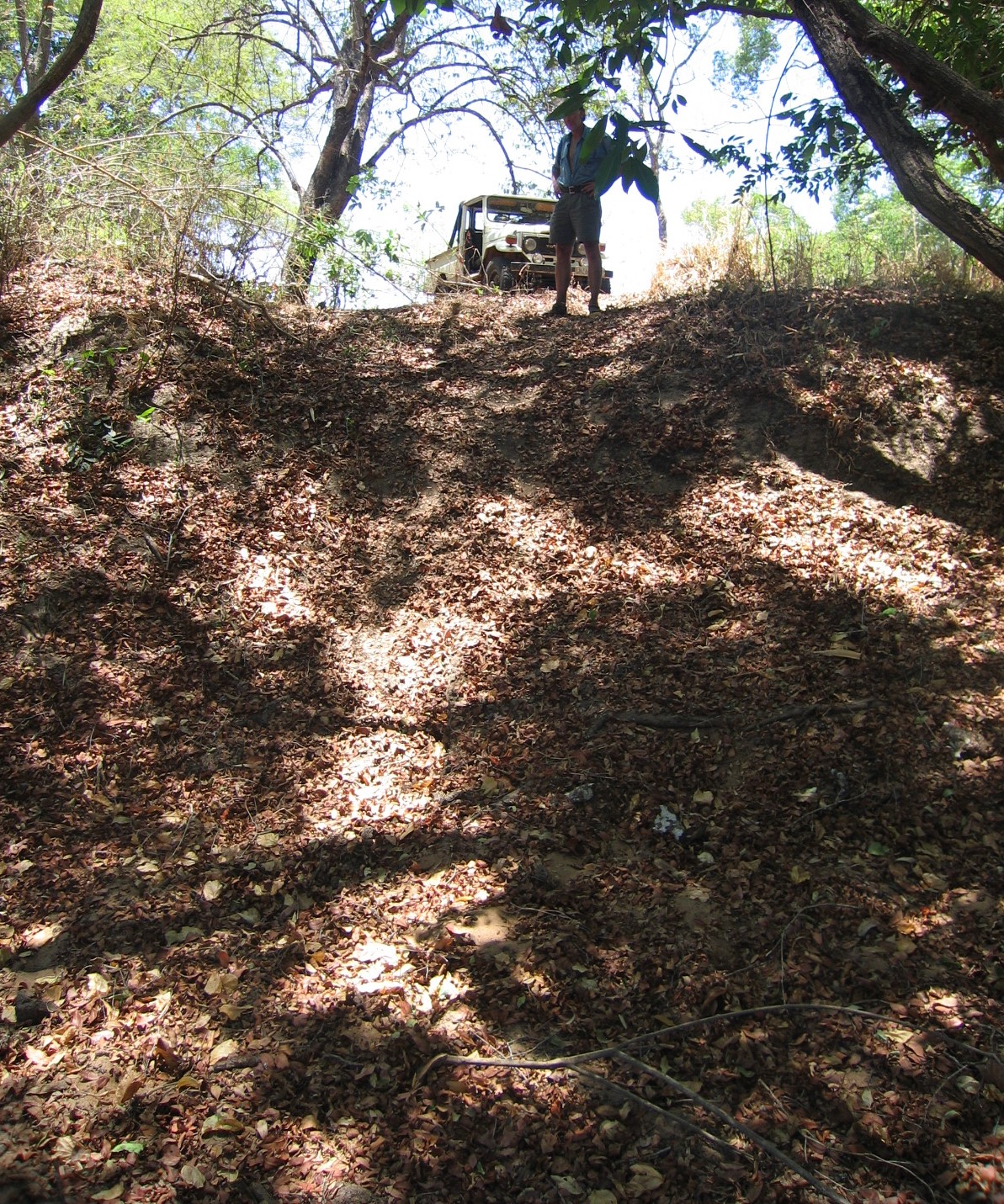Journeys back.
Elephant “road” through a deep a ravine. Having to go down feels daunting; how we got up and through on the way in is a bit of a mystery.
I have made remarks on African roads before, but in passing (if you’ll excuse the pun). There are the “official” ones, built with machinery and adamantly inserted into maps as navigable routes, and a lot can be said about that, for sure. But far more interesting and more extensive are the ones made by the inhabitants of the bush – to get to waterholes, salt licks, isolated villages, fishing spots, even trading connections. They are not noted anywhere and known only to local bush dwellers. So, I thought let me tell you a bit about them.
The wilderness is veined with a network of roads. They snake around trees, shrubs, anthills, boulders, along river banks, around hills and marshy areas… They are mostly feet-sized, but some are larger, almost open enough to drive a vehicle on. Some are many thousands of years old; some are more recent, even just seasonal. Some carry on for days. Some suddenly fade out after an hour or so, seemingly in the middle of nowhere – but if you pay careful attention, you will notice that you have arrived in a rich grazing area.
By far the greatest builders are the elephants. Even a smallish herd walking in file will, in a single pass, break open a clear and easily traversed path. But elephants, like many other bush dwellers, are creatures of habit and, while in an area, will tend to follow the same paths again and again, or the same long-distance migration routes to far-off grazing lands, or mineral licks, or reliable water sources. The result, in the case of elephants, are those huge, smooth-surfaced “highways” through the bush that are used by animals and humans alike.
Bush roads follow the way of least resistance. Nutritional energy is a scarce commodity in the bush, so elephants, and all other bush dwellers on the move avoid dangerous or energy-consuming areas like impenetrable thickets, marshy areas, deep ravines, rocky spots, steep places… The result is that paths almost never lead directly from a point to a destination. Rather, they seem to have minds of their own that at times make them veer alarmingly from the preferred direction. And that is without even mentioning the turn-offs, which are often undistinguishable from the “main” path and, at the point, may appear to be the better choice… To use the paths you require a lot of faith, or a guide with local knowledge; actually both.
I thought this passage from Paths of the Tracker illustrates the point quite well:
Early on the third day they came to what Henry said was an ancient elephant path. Aeons of kneading by the great feet had widened and levelled it so that it was almost like a made road, wide enough for a single car. After conferring with Fernando and Vasco Henry let them turn onto it.
“But this is going north. We have been heading north east. It’s going in the wrong direction,” Craig said immediately, glancing down at his GPS. “Look here,” and he held out the GPS to Henry.
Henry ignored the instrument and said mildly, “I know, but we are trying to use existing paths instead of taking a direct route through the bush.”
“But why? It’s daft. Why don’t we head directly where we want to go,” Craig insisted, challengingly.
Henry looked away, whipping the sapling he had in his hand at the irritation of the little black bees with more force than usual. He said slowly: “Because it’s easier to follow the existing paths.”
Craig kept quiet. What the hell is wrong with him. Why can’t he see it doesn’t make sense to wander off course on some ancient elephant path? He’s going to have us do miles of unnecessary walking.
Henry must have sensed what he was thinking. He swung the gun from his shoulder and rested the butt on the toe of his sandal. He cleared his throat and said in a voice that Craig sensed was deliberately calmed: “Look Craig, perhaps I should have explained this to you better, but to me it was self-evident, so it didn’t occur to me.”
His manner was agreeable, but with a simmer of impatience. He paused, taking a deep breath and said: “The direction we have been walking is not necessarily exactly the correct direction to Kgalamathe’s grave anyway. It was just the direction the path was heading. In fact, I don’t know where exactly Kgalamathe’s grave is from here. All I know is the general direction. And the path we have been following was close enough to that. Fortunate convenience. No more science than that,” and he paused, now smiling at Craig with a hint of apology.
“But this path is going to run out on us shortly, when we get to the fishing hole, Fernando says. The elephant path, on the other hand, will likely take us all the way to the Ruvuma. So we switch to that now, even though it might lead a bit too much north. Thing is, in my experience you get there quicker and less tired following these paths. You don’t have to cope with obstacles like deep ravines where you have to search for a crossing point, or very dense areas or difficult walking conditions. It’s also safer. So, I prefer using them.”
Henry blew hard through his nostrils to dislodge a little black bee. As he pinched his nose he said, “There is a network of small paths like this crisscrossing the African bush. Most were made by elephant and other game and a few by humans. But all use them. Some are permanent animal migration routes or ancient human trade routes that have been trodden open into broad pathways over millennia. This one I think is probably a migration path the elephant use to the north into Tanzania. That’s why I think it goes all the way to the Ruvuma. And across. But some paths are more local, you know, like to salt licks or waterholes or fishing areas or to where semi-nomadic bush people live. Sometimes they simply run out in the middle of nowhere.”
“Ok, so what then?” Craig said in a tone from which he could not quite keep triumphant derision.
Henry smiled at him, a patient smile, he noticed with fresh irritation. “Oh, then you keep heading in the general right direction until you hit another path. Of course, it’s a bit unlikely that it will lead in exactly the right direction, but you sort of zig-zag along. This one we’d probably have to turn off at some point, because we need to go a little more east.”
“But then how are you going to find the exact spot of Khalamathe’s grave in this bush?” Craig asked sceptically.
“Yeah, that’s not usually easy. At least not for me. Our African friends have an incredible natural sense of direction, and if they know that stretch of bush, it’s easy for them to get to a specific point. About equivalent to you knowing how to get to the gym in Pretoria. But none of them know the area where we are going. It’s quite a bit further than they usually roam around the village. But in this case it’s fairly easy, because it’s on the Liunde River not far from where it joins the Ruvuma. So, I think it’s best to go north to the Ruvuma along this path and then work east along the game paths there till we hit the Liunde where it joins the Ruvuma. Make sense?”
“Sure. I can see that that approach is better if one doesn’t have coordinates for the point one is aiming at,” Craig said a little loftily.
Henry looked at him quietly. After a moment he said, almost to himself, ”Even if I had the coordinates and could walk there in a straight line, I’d still use this path to the Ruvuma,” and he turned, lifting the gun onto his shoulder and started walking.


It takes a sensitive observer to notice, Salome.
Interesting how – not just Craig – but most of us in life want to control, with asbolute precision, how we reach our next “goal”, be it a destination, a personal challenge or a career goal. But we are almost always stubbornly blind to the fact that – just like these crissrossing African bushpaths – most of life’s “destinations” are reach, not through means that we can control with technology, money, planning and calculation, but rather through a range of unpredictable, uncontrollable factors that somehow, someday delivers us to some version of our final gaol goal after numerous disappointments, obstacles and the usual trial and error. If only we could make peace with the elephant path from the start, perhaps the journey will be more pleasurable and less frustrating.
So many beautiful metaphors in your books that relate to the clash between humans vs. nature, the new vs. the old, fate vs prediction, time vs. timelessness… Thanks for sharing!!